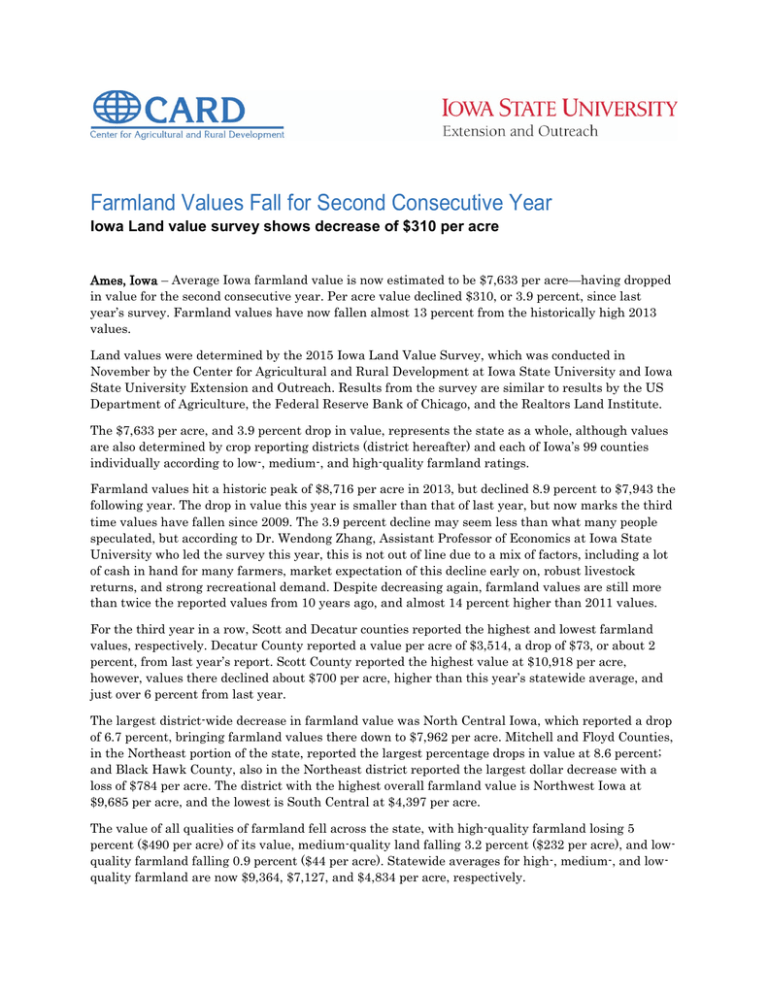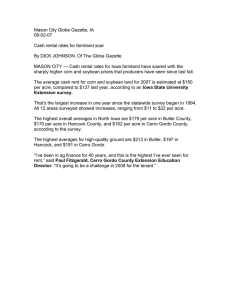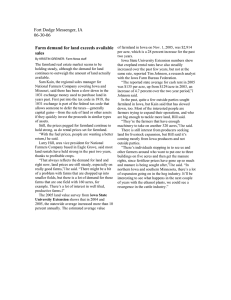Farmland Values Fall for Second Consecutive Year
advertisement

Farmland Values Fall for Second Consecutive Year Iowa Land value survey shows decrease of $310 per acre Ames, Iowa – Average Iowa farmland value is now estimated to be $7,633 per acre—having dropped in value for the second consecutive year. Per acre value declined $310, or 3.9 percent, since last year’s survey. Farmland values have now fallen almost 13 percent from the historically high 2013 values. Land values were determined by the 2015 Iowa Land Value Survey, which was conducted in November by the Center for Agricultural and Rural Development at Iowa State University and Iowa State University Extension and Outreach. Results from the survey are similar to results by the US Department of Agriculture, the Federal Reserve Bank of Chicago, and the Realtors Land Institute. The $7,633 per acre, and 3.9 percent drop in value, represents the state as a whole, although values are also determined by crop reporting districts (district hereafter) and each of Iowa’s 99 counties individually according to low-, medium-, and high-quality farmland ratings. Farmland values hit a historic peak of $8,716 per acre in 2013, but declined 8.9 percent to $7,943 the following year. The drop in value this year is smaller than that of last year, but now marks the third time values have fallen since 2009. The 3.9 percent decline may seem less than what many people speculated, but according to Dr. Wendong Zhang, Assistant Professor of Economics at Iowa State University who led the survey this year, this is not out of line due to a mix of factors, including a lot of cash in hand for many farmers, market expectation of this decline early on, robust livestock returns, and strong recreational demand. Despite decreasing again, farmland values are still more than twice the reported values from 10 years ago, and almost 14 percent higher than 2011 values. For the third year in a row, Scott and Decatur counties reported the highest and lowest farmland values, respectively. Decatur County reported a value per acre of $3,514, a drop of $73, or about 2 percent, from last year’s report. Scott County reported the highest value at $10,918 per acre, however, values there declined about $700 per acre, higher than this year’s statewide average, and just over 6 percent from last year. The largest district-wide decrease in farmland value was North Central Iowa, which reported a drop of 6.7 percent, bringing farmland values there down to $7,962 per acre. Mitchell and Floyd Counties, in the Northeast portion of the state, reported the largest percentage drops in value at 8.6 percent; and Black Hawk County, also in the Northeast district reported the largest dollar decrease with a loss of $784 per acre. The district with the highest overall farmland value is Northwest Iowa at $9,685 per acre, and the lowest is South Central at $4,397 per acre. The value of all qualities of farmland fell across the state, with high-quality farmland losing 5 percent ($490 per acre) of its value, medium-quality land falling 3.2 percent ($232 per acre), and lowquality farmland falling 0.9 percent ($44 per acre). Statewide averages for high-, medium-, and lowquality farmland are now $9,364, $7,127, and $4,834 per acre, respectively. The only district to show an increase in values as a whole was Northwest Iowa, which reported values 0.7 percent higher than last year. Clayton and Allamakee Counties, located in the Northeastern portion of the state, reported the largest percentage increases with a 2.9 percent gain. Of respondents that listed positive and/or negative factors influencing farmland values, low interest rates and high yields were the most commonly cited positive factors and lower commodity prices were the most frequently cited negative factor. High input prices, an uncertain agricultural future, and cash/credit availability were also cited as negative factors. With stagnant commodity prices, declining farm income forecast, a slowing Chinese economy, and a potential increase in interest rates, the Iowa farmland market appears to have peaked for the foreseeable future, and seems to continue drifting sideways to slightly lower. However, as Dr. Zhang put it, “It will most likely be an orderly adjustment as opposed to a sudden bubble burst. Most farmers will be able to weather the storm as the market prices find a new equilibrium, but farmers and land owners who bet on the high commodity prices lasting and aggressively expanded or borrowed heavily will face significant problems in the months ahead.” In the 2015 survey, over 75 percent of respondents thought land values in their territory would continue to decline next year. The majority predicted the decline would be either less than 5 percent or between 5 and 10 percent. The magnitude of the predicted drop depends on the location—areas relying heavily on corn and soybeans could see a bigger decrease. The survey was initiated in 1941 and is sponsored annually by Iowa State University. Only the state average and the district averages are based directly on the ISU survey data. The county estimates are derived using a procedure that combines the ISU survey results with data from the US Census of Agriculture. The Iowa Land Value Survey is based on reports by agricultural professionals knowledgeable of land market conditions such as appraisers, farm managers, agricultural lenders, and actual sales. It is intended to provide information on general land value trends, geographical land price relationships, and factors influencing the Iowa land market. The 2015 survey is based on 514 usable responses providing 708 county land values estimates. The survey was made available online for the first time this year, and 55 percent of participants chose this method as opposed to the traditional paper survey. A new web-portal has been developed at http://www.card.iastate.edu/farmland/ to pool various sources of Iowa farmland values and offer visualization tools like charts and interactive county maps.

